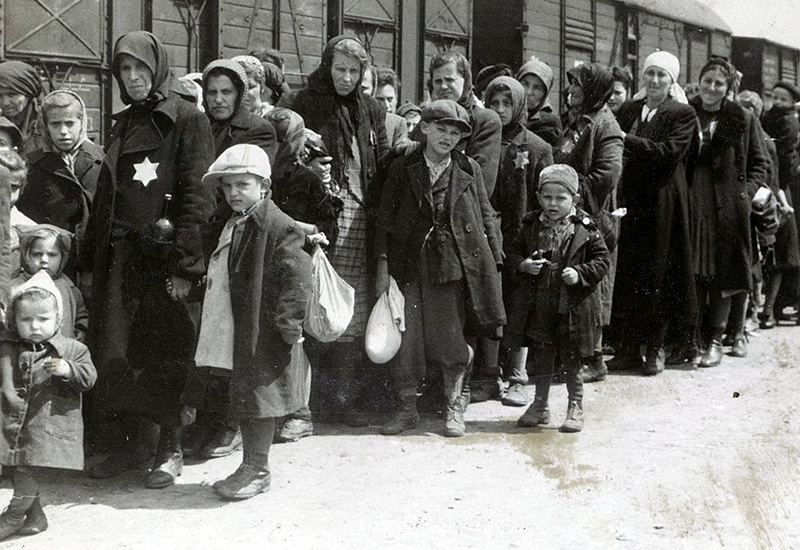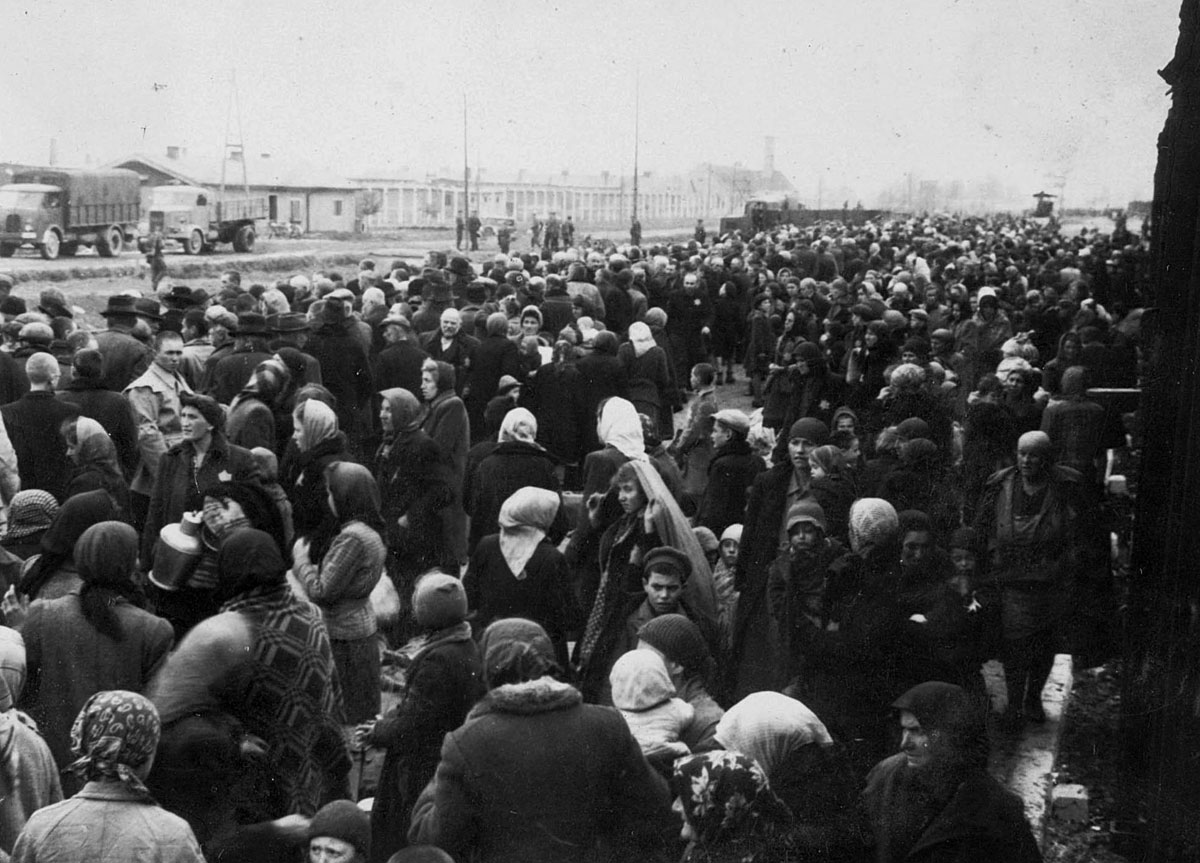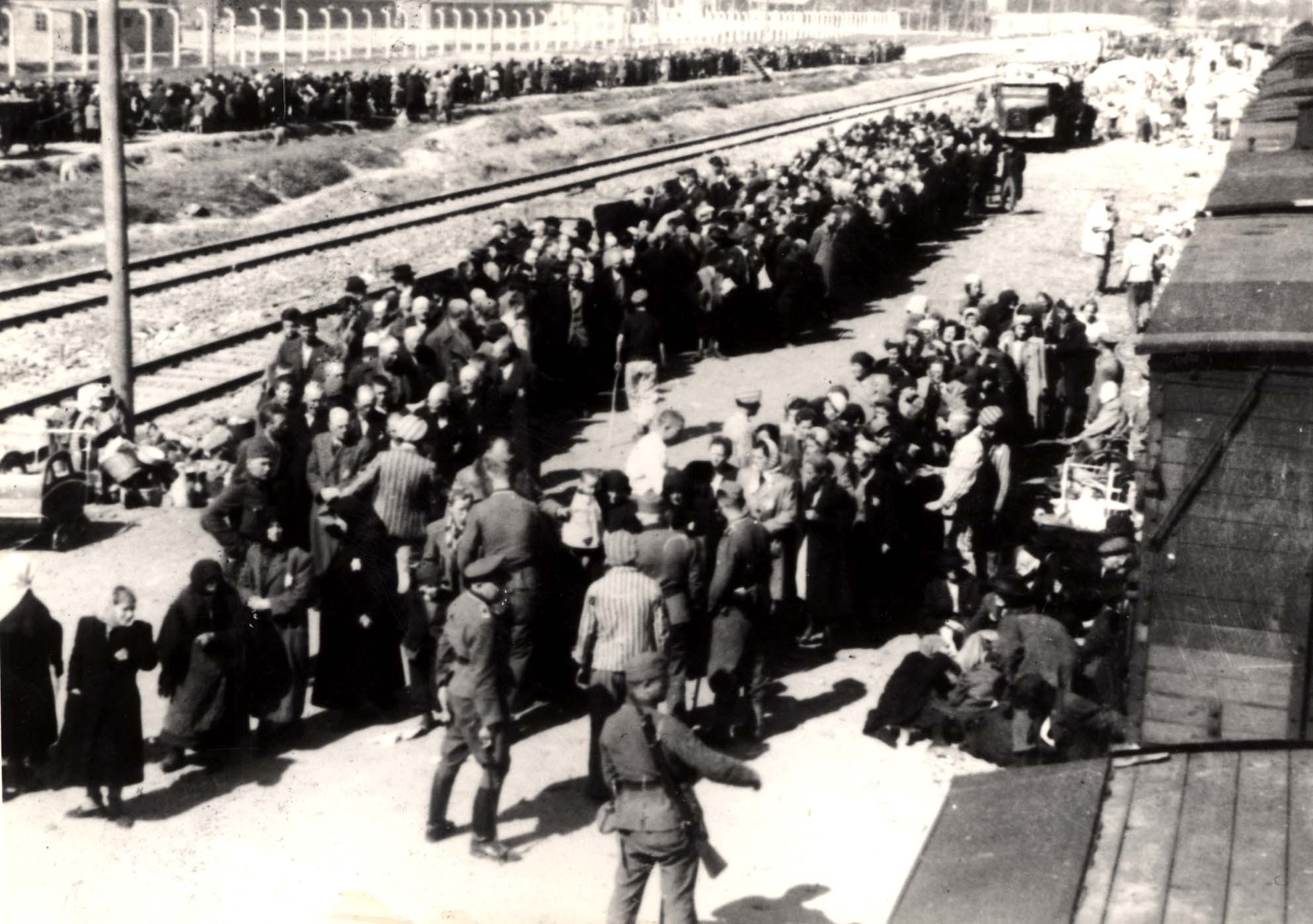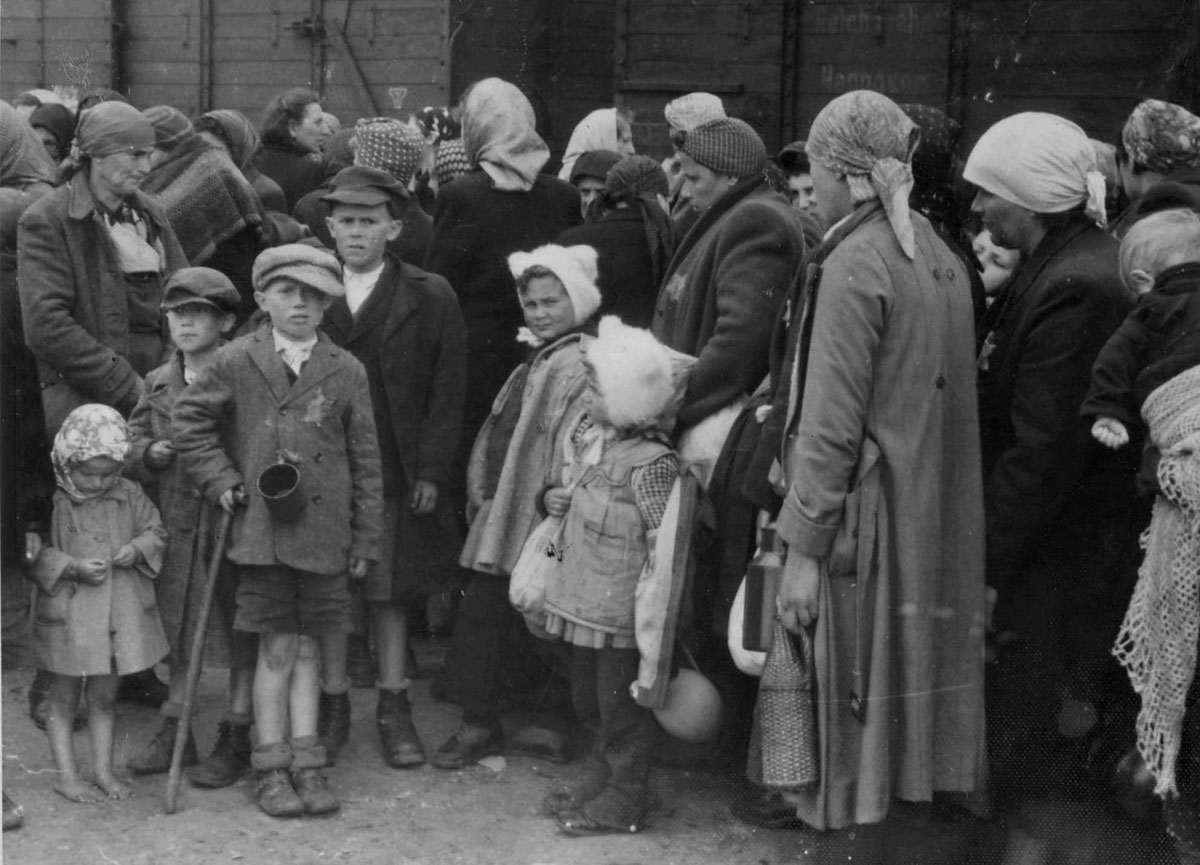Yad Vashem Photo Archive, FA268/10
Grades: 10 - 12
Duration: 1.5 - 2 hours
Didactic Objectives:
- Examine primary resources including testimonies and photographs relating to Auschwitz-Birkenau.
- Learn about how human beings were dehumanized by other humans, and how Jews were selected upon arrival Auschwitz-Birkenau.
- Gain insight into how prisoners sought to survive in this extermination camp. Think about the meanings of “liberation” after the Holocaust.
- Focus on the significance of Auschwitz-Birkenau within world history, remembrance and culture.
Introduction
Policy makers in more than twenty European nations have legislated Holocaust Remembrance days. For example, countries which mark January 27, the anniversary of the liberation of Auschwitz-Birkenau, as their national Holocaust Remembrance Day include: Croatia, Czech Republic, Denmark, Estonia, Finland, Germany, Greece, Italy, Liechtenstein, Norway, Sweden, and the United Kingdom. In addition, the United Nations has instituted January 27 as an International Day of Commemoration in Memory of the Victims of the Holocaust.
Auschwitz, and the commemoration of its liberation on January 27, 1945, has received a lot of media attention in recent years. Thousands of youth are annually guided through Auschwitz-Birkenau, and hear references to Auschwitz in various contexts. In an effort to deepen students’ understanding of the significance of Auschwitz-Birkenau in the history of western civilization, the International School for Holocaust Studies at Yad Vashem is pleased to make this lesson plan available.
What Was Auschwitz?
Auschwitz, located in Oswięcim, outside of Cracow, Poland, has become a symbol of the Holocaust. One of the main reasons that Nazi Germany established the camp there was because it was a central intersection of roads and railways. Before the Second World War, Jews living in Oswięcim, who were often artisans or merchants, constituted approximately half of this small town’s population. After the Holocaust, it may be argued that Oswięcim will forever be overshadowed by Auschwitz-Birkenau, the largest of the Nazi concentration camps and extermination centers.
Not only has Auschwitz become a symbol of the Holocaust due to its geographical size, but also because Jews were sent there from all over Europe to undergo selection and to be systematically murdered in gas chambers. In addition, we have many detailed testimonies of Holocaust survivors who survived the camp.
We say and write “Auschwitz,” but we actually mean a torture center, a terror that we cannot possibly conceive, the essence of evil and horror. Auschwitz was a huge complex built by human beings to murder other human beings in the cruelest industrialized manner.
Auschwitz was surrounded by high electric barbed wire fences, which were guarded by SS soldiers armed with machine guns and rifles. Some Holocaust survivors have said that not only did the barbed-wire surrounding Auschwitz tremble and howl, but also the tortured earth itself moaned with the voices of the victims.
In March 1942 trains carrying Jews began arriving daily. Sometimes several trains would arrive on the same day, each carrying one thousand or more human beings coming from the ghettos of Eastern Europe, as well as from Western and Southern European countries.
Note to the Teacher:
Overall, many moral, theological and educational issues arise when we discuss Auschwitz, but usually we are left with more open-ended questions than clear-cut answers. However, we should keep in mind that during the Weimar Republic (1919-1933), the Nazis began to wage their war of indoctrination as well as to assault their victims with words. Following their rise to power in 1933, verbal attacks were gradually followed by economic discrimination, imprisonment and later by physical destruction. It is imperative to remember that man’s inhumanity to man during the Holocaust did not originate in Auschwitz, but rather it began with racism, terror, anti-democratic legislation, and propaganda.
For more information on the names and identities of specific victims who were murdered during the Shoah, see: The Central Database of Holocaust Victims' Names.
What Happened at Auschwitz?
Between 1.3-1.5 million people were murdered in the gas chambers of Auschwitz, more than 90% of whom were Jews. The other ten percent were Poles, Soviet Prisoners of War, Sinti Roma, Jehovah Witnesses, homosexuals, and other undesirables. The vast majority of victims, who came from both Western and Eastern Europe including Belgium, France, Greece, Hungary, Italy, the Netherlands, and other countries, were unaware of their destination and of their fate. They were transported like animals in cattle-cars and arrived to the camp in a state of total collapse. Most of the people never really entered the camp, but just crossed through it on the way to the gas chambers.
Note to the Teacher:
There are no graves or memorial sites for the more than one million people who were murdered in Auschwitz. Unfortunately, the Nazis succeeded in depriving their victims of any identity – even in death. Our aim should be to restore the names and faces of the human beings, thereby thwarting the Nazi plan to erase them and their memory.
In her postwar testimony, Olga Albogen, a Holocaust survivor, relates to her family’s arrival in Auschwitz in the following way, “…We didn’t even say goodbye to Mother and the little ones. We just had some food yet from home and I gave it to my mother and said, “We’ll see you tonight.” And that was it and I never saw them again. It was such a commotion there in Auschwitz… So many people…And when they emptied the wagons, thousands and thousands and trains kept on coming from all over Europe, not just Hungary. It was just unbelievable.”1
Entire families often arrived in Auschwitz, but soon after their arrival, they were brutally broken apart. In Auschwitz-Birkenau, Jews were thrown out of the cattle cars without their belongings and forced to make two separate lines, men and women/children. SS medical personnel, including the infamous Dr. Josef Mengele, conducted selections among these lines, sending most victims to the gas chambers where they were usually killed and burned on the same day. Mengele and his colleagues also conducted so-called “medical experiments” on human beings in the camp.
The dehumanized minority often became registered prisoners with shaved heads in striped uniforms. Jews chosen for slave labor were stripped of everything, including outward differentiation between male and female. Prisoners’ personal identities were taken mainly by the act of tattooing their arms with numbers – replacing their personal names.
- How did prisoners endure such insurmountable conditions on a daily basis?
Jack Oran, a Holocaust survivor, relates:
"Everyone worked so hard, got beaten up…and came back to the camp – the exhaustion alone pushed him to the bunk to lie down and sleep throughout the night and get enough strength so that s/he might be able to do that again tomorrow. …In the morning, sixty percent of the six people [in the bunk] did not wake up. The other forty percent went over the pockets of the dead people to find a piece of bread…The hygienic condition was very, very poor in that period. I remember that I searched a dead body in the bunk and I found a piece of bread. That piece of bread was crawling with lice and you shook them off the bread and put it in your mouth and ate it. We all were crawling with lice. Taking a shower was not an option. To get out in the morning, to walk toward the barrack where there is water, running water – you didn’t want to walk through mud. If you walked through the mud you probably lost a shoe and then you had to go barefoot. So it would be damned if I do and damned if I don’t. Those were the conditions.”2
Although the Nazis terrorized and dehumanized prisoners in Auschwitz, as well as in other concentration camps under their control, many Jews attempted to retain their dignity and humanity.
Even in unendurable conditions, people sought support, cooperation, and friendship. For instance, Ovadiah Baruch, a young Jewish prisoner who was deported to Auschwitz from Greece, notes that the support of his friends helped him survive. He states:
“During the death marches [from Auschwitz] we were three friends, Yom Tov Eli, Michael, and I. We were connected heart and soul. Throughout the whole time we were prisoners in Auschwitz we stayed in close contact….During the death marches, Michael developed dysentery. He was so weak that he could barely continue to walk, and he begged us to go on without him. Yom Tov Eli and I insisted that we would carry him and support him as best as we could.”3
Discussion Questions:
- Some Holocaust survivors have said that people who were immediately sent to the gas chambers were the “lucky ones.” After reading Jack Oran’s testimony, why do you think that some Holocaust survivors believe that those who were condemned to death upon arrival in Auschwitz were “lucky?”
- After reading the testimonies of Jack Oran and Ovadiah Baruch, what do we learn about how prisoners in Auschwitz tried to survive on a daily basis?
Pages of Testimony of Auschwitz Victims:
- Andre Israel
- Mirjam Moskowitz
- Fanny Peczenik
- Maurice Zweig
How Was Auschwitz Liberated?
By January 1945, almost five years after the camp had been in operation, Soviet troops were advancing towards Auschwitz. The Nazis, desperate to withdraw, sent most of the remaining prisoners on death marches westward at the height of winter. Many prisoners were killed en route to the Reich. Soviet soldiers liberated Auschwitz on January 27, finding approximately 7,650 prisoners throughout the entire camp complex, who were barely alive.
Private Zinovil Tolkatchev (1903-1977) was an official artist of the Red Army and joined up with Soviet forces that liberated Auschwitz in early 1945. Tolkatchev was seized by the urge to depict what he saw. In the absence of drawing paper he entered the camp’s former headquarters and took stationery with bold black letters: Kommandantur Konzentrationslager Auschwitz; I.G. Farbenindustrie Aktiengesellschaft; Der Oberpräsident der Provinz Oberschlesien and began to draw. Ironically, on these very same pieces of paper just a few days prior were written orders of extermination. Abutting the sketches, Tolkatchev added densely written lines with the testimony of the few survivors able to utter words. He also jotted repeatedly “to remember, not to forget.”
Bela Braver, a Holocaust survivor from Poland who was deported to Auschwitz, was liberated in 1945 in Czechoslovakia by the Soviet Red Army. She notes, “The camp guard who came to open the gate said, ‘You are free and you can leave.’ All the guards with the dogs that used to stand in every corner had disappeared. It was all gone, as though it had never been. It was one of the miracles! The Russians entered, and we were in such a condition that no one moved, no one went out. We did not laugh, we were not happy, we were apathetic - and the Russians came. A general came in, he was Jewish. He told us that he was delighted, as this was the first camp in which he found people still alive. He started to cry; but we didn’t. He wept and we didn’t.”6
Eva Braun, a Holocaust survivor from Slovakia who was deported to Auschwitz, was liberated in 1945 at Salzwedel by the US Army. She recalls, “While I was elated by the freedom, there was tremendous fear. Who would I find? We had survived this but we now have to go back to civilization. How would we react in a normal world again. We were two young girls without anything. Who will take care of us? What will we do? It was euphoria, but is was a very ambivalent feeling. We were frightened.”5
Concluding Discussion Questions
- Visit the online exhibition of the drawings of Private Tolkatchev. How did this artist express the liberation of Auschwitz?
- Compare and contrast the excerpts of Eva Braun and Bela Braver. After liberation by the Allies, how did these former prisoners react?
- Upon liberation, Bela Braver was told that she “can leave.” Although Bela had been liberated, was she indeed “free”? Why or why not?




- 1.Yad Vashem Archives O.3-10335.
- 2.Yad Vashem Archives 0.3-8181.
- 3.Yigal Shachar, Oh Madre (Jerusalem: Yad Vashem, 2002), pp. 86-87 [Hebrew].
- 6.Yehudit Kleiman and Nina Springer-Aharoni (eds.), The Anguish of Liberation, Testimonies from 1954 (Jerusalem: Yad Vashem, 1995), p. 19. For more sources related to the liberation of Auschwitz, we also suggest that you read the works of Primo Levi (1919-1987), an Italian-Jewish Holocaust survivor and author.
- 5.Ibid, p. 45.
